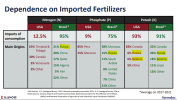Foggy, I gotta tell you I think you can get by on your gut feelings for a long time. I know soil testing is almost a Holy Grail but I've come to believe it to be inadequate for some purposes (think production ag) and needed less frequently, if at all, for most food plotters - if you know your soils and their origins. It never changes so you only need to find out once and develop one plan forever. I'll save the rest of the story for later.
Moving on.....
Let me ask anyone listening, in light of high input prices, travel to-and-from aside, what are you going to do? I know many of you have developed "alternative" systems where you believe purchasing inputs is unnecessary and I say good for you. But, if you've been using chemical herbicides and synthetic fertilizers while buying and applying lime religiously, what are your going to do -now?
I don't think soil pH is as important as we think (except you guys south of 5 downwind of the rust belt). We assign blame to pH because that's what we've always done and it's easy to illustrate that it isn't perfect via soil test.
There are plenty of other reasons for plots to not do well when managed with modern best practices. That could be fallow, lack of oxygen, excess oxygen, surface soil temps, too much water, not enough water, no mycorhizal fungi, imbalanced C:N ratio, herbicides, seed coatings, erosion, too much residue, not enough residue, etc. All of those are crisis of human intervention and preventable. I have used lime to knock out some pH specific weeds though, so don't think I'm anti-lime. There's just more to it.
What am I going to do differently this year? Maybe cut back my gypsum rate, integrate human food into my plots, building more perma-garden beds, and I'm tinkering with one other thing I can't share because I'm already having sourcing problems and don't need you characters googling for it too.
I've been researching for years how to get rid of as many interventions as possible. I started a thread last year asking what people would do if they couldn't get fertilizer. I think a couple of other threads also came up around that time as well. I remember one guy on here got to scoffing and puffing, calling it doom porn. Yet here we are.
Anyway, everyone better get curious about how to grow things without Russian and Chinese inputs. Ain't saying they're gonna get cut off for good, but I wouldn't bet my life on them always being available either.



